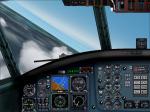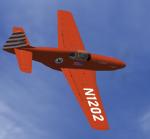All Files > Page 5


HU-16_METAL_HAF
(Category: FS2004 > Props)
20.60Mb (126 downloads)
Albatross HU-16T!!!
After your request I made it.
I draw this airplane, which is a remake of HU-16A with turbo prop engines.
The package include:
High resolution textures with reflections, BLANK!!!, so you
can repaint with your own textures if you wish),
Full moving parts, panel, and checklist.
I want to have a small file, that's why I used default sounds, and most of the default gauges as well.
The 3Dmodel, panel & airfile and textures was made it by Anthony Konstantinidis
Some gauges by unknown authors.
Posted Dec 2, 2025 08:52 by Anthony Konstantinidis

FSX/P3D Boeing 737 Max 8 Batik Air Malaysia package
(Category: FSX > Civil Jets)
85.10Mb (181 downloads)
FSX/P3D Boeing 737 Max 8 Batik Air Malaysia package. With its main hub at Kuala Lumpur International Airport, Batik Air Malaysia currently operate 17 Boeing 737 Max 8 flying to destinations all over Asia as well as Australia and New Zealand.
The high spec Boeing 737-Max 8 from TDS. The virtual cockpit (VC) is the Microsoft/Alejandro Rojas Lucena/FSND base modified by Speedbird77 to resemble a Max cockpit, including gauges by G. Munro.
There are custom CFM eco sounds included for that extra realism. Use - Instrument panel - Util for ground vehicles, doors stairs, fuel truck, buses. New Utility allows Bus, fuel, doors and more. (Go to Views - Instrument panel - Utility). VC added and edited to allow correct VC views, correct jetways and wheel levels. Credits go to TDS fantastic native FSX Boeing Max8 model. I added PDF B737 checklist.
Textured, packaged and prepared for FSX & P3D by Chris Evans.
Posted Dec 1, 2025 15:07 by chris evans
Hughes H500
(Category: FS2004 > Helicopters)
14.49Mb (100 downloads)
Hughes H500 for FS2004 3 models and 18 textures.
Is one of the world's most popular light turbine helicopters. It's rugged construction, operational performance and reliability combined with crisp handling and manoeuvrability make it the favourite of many helicopter pilots.\n\nSeveral different civilian and military versions have been built. Civilian versions include, amongst others, the 500C and 500D (1000 examples built since 1975), 500E (with longer fuselage, in production since 1982), 530E (new 485 kW engine built since 1983).
atc_heavy=0The Hughes 500 is one of the world's most popular light turbine helicopters. It's rugged construction, operational performance and reliability combined with crisp handling and manoeuvrability make it the favourite of many helicopter pilots.
Several different civilian and military versions have been built. Civilian versions include, amongst others, the 500C and 500D (1000 examples built since 1975), 500E (with longer fuselage, in production since 1982), 530E (new 485 kW engine built since 1983).
Posted Nov 29, 2025 20:14 by Anthony Konstantinidis


FSX/FS2004 N.A. P-51C Mustang N1202 “Excalibur III”
(Category: FSX > Vintage)
7.37Mb (197 downloads)
MSN 111-29080 was built in Dallas in 1944 and delivered to the USAF as 44-10947. After the war, it was sold to Paul Mantz as NX1202. Mantz converted the aircraft to a “wet” wing where the complete wing is a fuel tank. He then won the 1946 and 1947 Bendix Trophy Races, and, with different pilots in the cockpit, NX1202 came second in the 1948 Bendix race, and third in the 1949 race. Mantz then sold the aircraft to Captain Charles Blair who, on January 31, 1950, set a world record flying from New York to London in 7 hours and 48 minutes. On May 29, 1950, Captain Blair flew from Bardfoss, Norway, over the North Pole to Fairbanks, Alaska, in another world record of 10 hours 27 minutes. He then set yet another world record by flying from Fairbanks to New York in 9.5 hours. In 1952 Captain Blair was awarded the Harmon International Trophy by President Truman. N1202 was sold to Pan American World Airways in 1953, who promptly donated her to the Smithsonian Institute. Today, she is on display at the Udvar-Hazy Center in Washington DC.
Painted on to A.F. Scrub’s magnificent P-51B Mustang, I have modified, with permission, the wing to give Trans-Continental and Trans-Atlantic range. Enjoy
Posted Nov 29, 2025 19:20 by Steve Morley


do-1286 ALBATROS
(Category: FS2004 > Props)
7.27Mb (62 downloads)
FS2004 Dornier 128-6 the unfinished" Detailed Gmax rebuild with completely instrumented flyable VC though with FS2004-style levers and unfinished interior. Just about all that moves on the real thing moves accordingly here. Further improved flight characteristics using the FS9 turboprop model now featuring properly flat-rated PT6A-110 engines. gmax design partner Antonis "Anthony" Konstantinidis reappears again (the detailed outside texturing is also by him) Probable FS-first: VHF Homing Indicator by Roman Stoviak. Panel, most gauge programming, soundset and flight dynamics by Mathias Elsaesser.
Posted Nov 29, 2025 17:39 by Anthony Konstantinidis

CYUL Montreal Dorval
(Category: FS2004 > Scenery)
6.64Mb (22 downloads)
This scenery is based on a chart in the Pan Am Atlantic Division Manual for 1946 and is intended to cover propliner operations at Dorval down to about the mid 1950s. The hangars and terminal are custom built.
Posted Nov 29, 2025 15:58 by Ken Lawson


DO_1286 bare METAL
(Category: FS2004 > Props)
68.90Mb (74 downloads)
FS2004 Dornier 128-6 the unfinished" Detailed Gmax rebuild with completely instrumented flyable VC though with FS2004-style levers and unfinished interior. Just about all that moves on the real thing moves accordingly here. Further improved flight characteristics using the FS9 turboprop model now featuring properly flat-rated PT6A-110 engines. gmax design partner Antonis "Anthony" Konstantinidis reappears again (the detailed outside texturing is also by him) Probable FS-first: VHF Homing Indicator by Roman Stoviak. Panel, most gauge programming, soundset and flight dynamics by Mathias Elsaesser.
Posted Nov 28, 2025 20:51 by Anthony Konstantinidis

FSX/P3D Airbus A321NEO Air Busan package
(Category: FSX > Civil Jets)
90.70Mb (222 downloads)
FSX/P3D Airbus A321NEO Air Busan package. Air Busan is a South Korean low cost airline based in Busan. Air Busan currently operate 5 A321NEO flying to destinations all over Asia.
Model by Project Airbus with NEO engine mod by Bret Herman. Updated VC by Speedbird77 with built in FMC by Garret Smith. Includes A320 operation manual and checklist. PW sounds included. Textured, assembled for P3D v5.4 by Chris Evans. Should work in FSX and other P3D
Posted Nov 27, 2025 16:45 by chris evans


FS2004 Dornier 128-6_corona
(Category: FS2004 > Props)
69.65Mb (86 downloads)
FS2004 Dornier 128-6 the unfinished"
Detailed Gmax rebuild with completely instrumented flyable VC though with
FS2002-style levers and unfinished interior.
Just about all that moves on the real thing moves accordingly here.
Further improved flight characteristics using the FS9 turboprop model now featuring properly flat-rated PT6A-110 engines.
gmax design partner Antonis "Anthony" Konstantinidis
reappears again (the detailed outside texturing is also by him)
Probable FS-first: VHF Homing Indicator by Roman Stoviak.
Panel, most gauge programming, soundset and flight dynamics by Mathias Elsaesser.
Posted Nov 27, 2025 01:01 by Anthony Konstantinidis


NAMC YS-11
(Category: FS2004 > Props)
36.90Mb (183 downloads)
NAMC YS-11 v.2.7, ANA / ANK Package.
New features: improved model with feathering
prop blade animation and parking mode with
streamers, wheel chocks etc. Better VC with new
night lighting, smooth gauge update rate,
more clikckable controls and VC window rain
effects. This is a complete aircraft
containing panel, sounds and effects. No
previous version needed. Manual included.
Author: Esa Kaihlanen et al. /AFG/
texture:Anthony Konstantinidis
Posted Nov 27, 2025 00:21 by Anthony Konstantinidis






